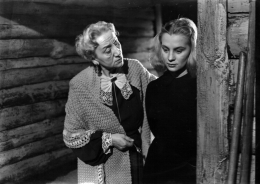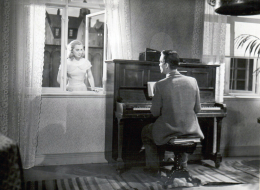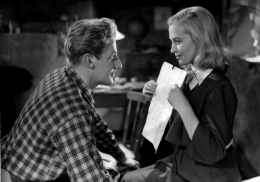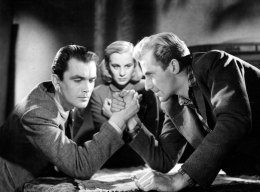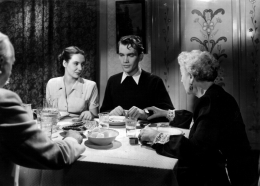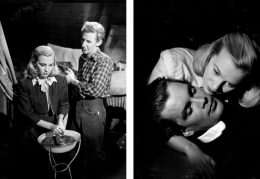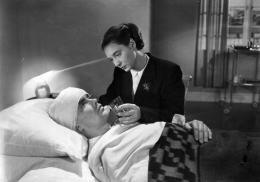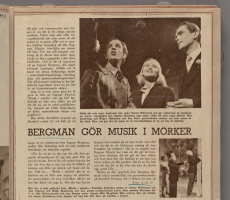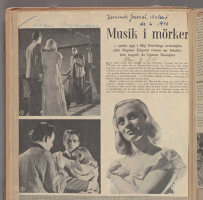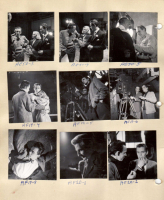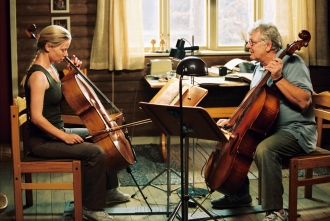Music in Darkness
A talented musician blinded during his military service is gripped by increasing bitterness.
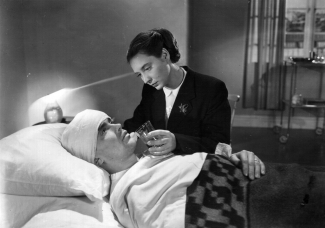
"My only memory of the filming is that I kept thinking: Make sure there are no tedious parts. Keep it entertaining. That was my only ambition."Ingmar Bergman
About the film
Dagmar Edqvist's novel Musik i mörker (Music in Darkness) was published in 1946.
Bergman writing on the genesis of the film in Images: My Life in Film:
In spite of all that happened, Lorens Marmstedt did not throw me out. With great diplomacy he pointed out that now would be the perfect time for at least one modest audience success. Otherwise my days as a movie director migth be numbered. A Ship Bound for India as well as It Rains on our Love had been made for Sweden's Folkbiografer. Now Marmstedt suggested that I make a film for his own company, Terrafilm. It must be noted that Lorens was a passionate gambler, able to put his money on the same number a whole evening.
He had bought the movie rights to a novel by Dagmar Edqvist called Music In Darkness, which told the story of a blind musician. For the time being I would have to stuff my demons into an old sack. Here I was not going to have any use for them. I read the novel; I hated it and decided to tell Lorens how I felt. He declared the he had no intention of coming up with any other offer. Finally we agreed that we would go and see Dagmar Edqvist together. She turned out to be an adorable woman, funny, warm, and intelligent. Also very feminine and pretty. I caved in. She and I would write the screenplay together.
Shooting the film
Bergman in Images:
'My only memory of the filming is that I kept thinking: Make sure there are no tedious parts. Keep it entertaining. That was my only ambition. Music in Darkness (known in the United States as Night is My Future) became a respectable product in the style of director Gustaf Molander. It was generally well received and was a modest box-office success to boot.'
Epilogue
Music in Darkness was screened at the Venice Film Festival in 1948, where it was well received by audiences and critics alike. This was probably due in no small part to Mai Zetterling, then on the verge of her international breakthrough.
Sources
- The Ingmar Bergman Archives.
- Ingmar Bergman, Images: My Life in Film.
- Ingmar Bergman, The Magic Lantern.
C B-n in Dagens Nyheter:
No, I think that Ingmar Bergman is on a perilous course if his film adaptations of modern Swedish fiction follow the template he has made for himself in Music in Darkness. Naturally, there is something to draw comfort from. One must be pleased that Swedish film production, which increasingly comprises so much that is coarse and so many faux pas, now has a director with such impeccable artistic aspirations as Ingmar Bergman, so conscientious when it comes to keeping the weeds at bay. His new film Music in Darkness is visually attractive throughout, precise down to the last detail, as smooth as silk.
Filmson in Aftonbladet:
The subject of the film would have been completely repellent had Bergman not carried over so much Dagmar Edqvist's unsentimental sympathy for the world of blind people and his portrayal of their rational view of what is a particularly complicated, yet otherwise universal human existence. But first and foremost this is a film about young, awkward, yet ultimately devoted love, and in this too, Ingmar Bergman has managed to achieve a profound warmth and tenderness in the screen narrative previously only hinted at. To begin with, Mai Zetterling is somewhat affected as the young servant girl, but her true, heart-felt womanly qualities grow, and her pale, translucent face has an air of avowed simplicity which is beautifully offset by Malmsten's dark, reserved warmth.
Nils Beyer in Morgontidningen:
There were, in Dagmar Edqvist's novel, so many fine psychological nuances that have been lost in the film. Ingmar Bergman has not put his whole heart into this story of the blind musician, who after a tough inner and outer struggle manages to overcome his handicap. The entire social element of his plight has been conjured away. What has captivated the director is blindness as a state of anxiety and finally he solves all the difficulties via a thoroughly conventional happy ending.
"In its lyricism, Music in Darkness is a captivating film. A trifle slow perhaps towards the end, yet nonetheless an example of a film that is better than the book on which it is based."
Robin Hood in Stockholms-Tidningen
Distribution titles
Música en la oscuridad (Spain)
Musiikkia pimeässä (Finland)
Musik i mørket (Denmark)
Musikk i mørket (Norway)
Musique dans les ténèbres (Belgium)
Musique dans les ténèbres (France)
Night Is My Future (Great Britain)
Night Is My Future (USA)
Noche eterna (Spain)
Production details
Production country: Sweden
Swedish distributor (35 mm): Terrafilm, Stjärnfilm
Swedish distributor (DVD): Studio S Entertainment
Laboratory: Film-Labor
Production company: Terrafilms Produktions AB
Original work: Musik i mörker (Novel) by Dagmar Edqvist
Aspect ratio: 1,37:1
Colour system: Black and white
Sound system: Optical mono
Original length (minutes): 88
Censorship: 073.134
Date: 1948-01-15
Age limit: 15 years and over
Length: 2350meter
Censorship: 073.134
Date: 1962-05-28
Age limit: 15 years and over
Length: 2390 metres
Release date: 1948-01-17 Royal, Stockholm, Sweden, 88 minutes
Filming locations
Sweden (1947-11-01-1947-12-30)
AB Sandrew-Ateljéerna, Stockholm (the central studios)
Music
Title: Serse. Ombra mai fù/Largo Alternative title: Largo
Composer: Georg Friedrich Händel (1738)
Lyrics: Nicola Minatò (1738) Silvio Stampiglia
Instrumentalist: Birger Malmsten
Title: Sonat, piano, nr 14, op. 27:2, Alternativ titel: "Moonlight sonata"
Composer: Ludwig van Beethoven (1802)
Title: Fantasistycke, piano, op. 12. No 2 Alternative title: Aufschwung
Composer: Robert Schumann (1837)
Instrumentalist: Birger Malmsten
Title: Ballad, piano, no 3, op. 47
Composer: Frédéric Chopin (1840-41)
Comment: Instrumental.
Title: Vals, piano, no 7, op. 64:2
Composer: Frédéric Chopin (1846-1847)
Instrumentalist: Birger Malmsten
Title: Bedstefars Vals Alternative title: Se, farfar dansar gammal vals
Composer:Tom Andy (Alias) (1932)
Lyrics: Arvid Müller (Danish lyrics 1932) Dix Dennie (Alias) (Swedish lyrics 1932)
Instrumentalist: Birger Malmsten
Title: Modlitwa dziewicy/La prière d'une vierge Alternative title: Jungfruns bön
Composer: Tekla Badarzewska-Baranowska (1851)
Instrumentalist: Birger Malmsten, Gunnar Björnstrand
Title: Preludium, piano, no 24, op. 28, d-minor
Composer: Frédéric Chopin (1836-38)
Comment: Instrumental.
Title: Swingimprovisation
Composer: Erland von Koch (1948)
Instrumentalist: Reinhold Svensson
Title: Symfoni, no 3, op. 55. Sats 4 Alternative title: Eroica.
Composer: Ludwig van Beethoven (1804)
Comment: Instrumental (grammofonskiva).
Title: Nocturne, piano, op. 9. Nr 2
Composer: Frédéric Chopin (1831)
Instrumentalist: Birger Malmsten
Title: Raymond. Uvertyr
Composer: Ambroise Thomas (1851)
Lyrics: Joseph Bernard Rosier (1851) Adolphe de Leuven (1851)
Comment: Instrumental (grammofonskiva).
Title: Treulich geführt, ziehet dahin. Alternative title: Bridal march. From Lohengrin
Composer: Richard Wagner (1850)
Lyrics: Richard Wagner (German lyrics 1850) Fritz Ahlgrensson (Swedish lyrics 1874)
Comment: Instrumental.
Beatrice: Greed brings a man to defile the commandments by embezzling. And then he takes his life.
Bengt: I was his life, after all.
Augustin: Beatrice regards suicide as murder.
Beatrice: Isn't that so? It is a crime against life.
Agneta: We don't know what he endured.
Beatrice: Everything can be born. Pain and suffering are part of God's plan.
Agneta: Perhaps he was driven by despair?
Beatrice: Despair? Despair is merely a momentary fit of impatience in the grand scheme.
Lovisa, the housekeeper: So, you read for quite some time?
Ingrid: We have permission to do so.
Lovisa: We are going to read many books, all winter.
Ingrid: No good will come of that. You come from a peasant stock and you are as good as city folk.
Beatrice: Remarkable how that girl has grown up.
Bengt: Has she?
Beatrice: Don't you find her accommodating?
Bengt: Yes, she is sweet.
Beatrice: You need a wife to look after you.
Bengt: Look after me? Thank you. So I could marry the little wench?
Beatrice: Shame on you! You could do worse. Besides, she may not want you.
Bengt: So my last resort doesn't exist.
Hedström: And don't be satisfied with the secondary exam, aim higher. What do you say?
Bengt: I can't. I just want to exist, nothing more.
Hedström: The community needs you. Your example will state their case.
Bengt: I can't. I don't want to. Don't badger me!
Bengt: The young woman accompanies the victor.
Ingrid: Why did you say that?
Bengt: It's a joke, can't you tell?
Ebbe: Ingrid is sensitive to tone lately.
Bengt: Be careful around people. They suddenly see through things.
Ingrid: I'm going to continue my studies.
Lovisa, the housekeeper: Not when you messed up things like this.
Ingrid: I haven't messed anything up.
Lovisa: What? Aren't you pregnant?
Ingrid: No.
Lovisa: Why are you getting married then?
Mark Sandberg, 1996:
Still waiting for a financial success after four tries, Bergman took on a film story meant to guarantee a profit-or rather, more or less constrained to do so. To the relief of his producer, this film actually was a modest success.
The conventional storyline relates the developing relationship between Bengt, a young musician blinded in an accident during his military service, and Ingrid, a lower-class servant girl in the home of Bengt's parents. In A Ship Bound for India, blindness is a minor motif; here it is developed into a full-blown psychological study and metaphor for youthful angst
The feverish dream sequence after the initial accident is particularly vivid and striking, especially given the cinematic constraints inherent in depicting a blind person's subjective experience. Bergman's restless early experiments with different styles here includes the classic Hitchcock conceit of filming himself in cameo; look for a young Bergman as a passenger on the train at the end of the film.
Collaborators
- Mai Zetterling
- Birger Malmsten
- Olof Winnerstrand
- Naima Wifstrand
- Birgit Lindkvist
- Hilda Borgström
- Douglas Håge
- Gunnar Björnstrand
- Bengt Eklund
- Åke Claesson
- John Elfström
- Rune Andreasson
- Bengt Logardt
- Marianne Gyllenhammar
- Sven Lindberg
- Barbro Flodquist
- Segol Mann
- Ulla Andreasson
- Svea Holst
- Georg Skarstedt
- Reinhold Svensson
- Mona Geijer-Falkner
- Arne Lindblad
- Stig Johanson
- Britta Brunius
- Erik Forslund
- Otto Adelby
- Ida Otterström
- Ulf Johanson
- Ingmar Bergman
- P.A. Lundgren, Art Director
- Bengt Westfelt, First Assistant Cameraman
- Göran Strindberg, Director of Photography
- Gösta Petersson, Unit Manager
- Lennart Wallén, Film Editor
- Olle Jakobsson, Production Mixer
- Dagmar Edqvist, Screenplay
- Erland von Koch, Music Composer
- Lorens Marmstedt, Producer
- Allan Ekelund, Production Manager / Production Coordinator
- Sven Björling, Property Master
- Ulla Kihlberg, Script Supervisor
- Inga Lindeström, Make-up Supervisor
- P A Lundgren
